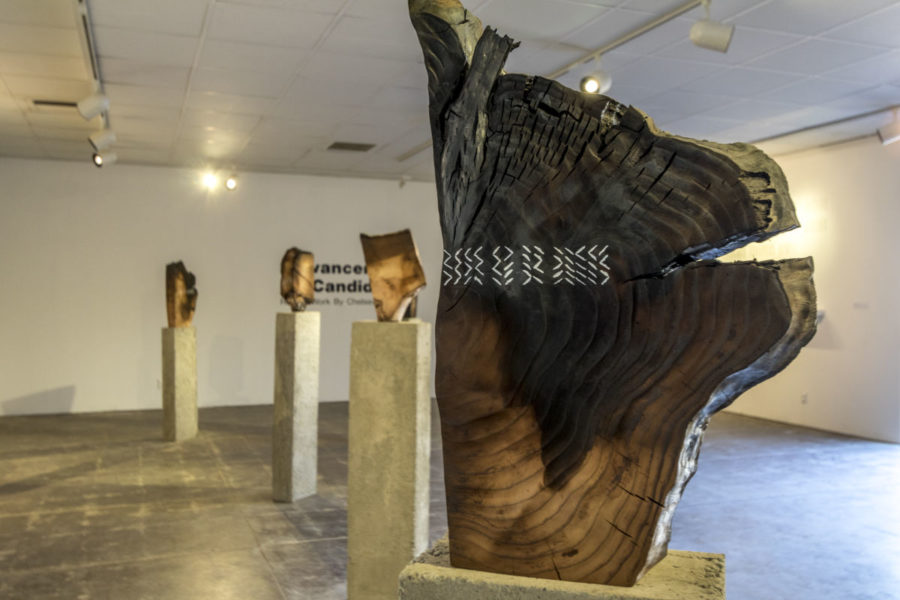Artist uses binary code to spark conversation
Chelsea Thompto’s artwork uses a binary system of language for a non-binary conversation, on display at the Robert Ellis Gallery, Oct. 12, 2015.
October 14, 2015
“Advancement to Candidacy,” the current exhibit going on in the Robert Else Gallery, had its reception on Oct. 8. The artist, Chelsea Thompto, had the opportunity to hear from viewers about her latest work. The exhibit’s intention was to start a conversation and answer questions about the issues that surround the transgender community.
Thompto mentioned that her powerful experience in transitioning from man to women over the past six years has mentally opened and inspired her to talk about, in her art pieces, the discrimination and hate that transgender people go through.
{{tncms-asset app=”editorial” id=”693b3c46-72fc-11e5-9162-9b3e07edd8e0″}}
“As I made works, I deepened my understanding about what it means to be a transgender and what the experience is about,” said Thompto. “I am able to kind of use these sculpture materials as an allegory to start a talk about transgender issues.”
The exhibition is composed of 18 different sculptures of burnt wood along with an implemented code written in each of the pieces.
In order to express the transformation that transgender individuals go through, Thompto burned wood by using a process in which each piece still gets to keep its shape.
The binary writing system Thompto came up with was carefully and meticulously labeled on the six torsos of burnt wood and the 12 individual smaller pieces with white acrylic paint.
The code writing on the main wall, written in charcoal, can also be appreciated. Thompto explained that both the white code writing on each of the pieces and the black code writing on the wall are a reflection mirage.
In her own words, Thompto explains that the mirage provided a conversation about the taboo of gender transition.
“The conversation between the work and the space, is kind of an analogue to the conversation between society and the transgendered people, the social issues and problems that arise from that,” said Thompto.
At her artist statement, Thompto provides the formula to decode the binary writing system, so viewers can decode each piece’s writing and discover the hidden message in each. This was a way to start the conversation between the viewers and the art itself.
Decoding the meaning of each piece was something that many of the attendees enjoyed.
“It is very interesting; I like that we actually look, decoded and spent some time looking and seeing what [the code] means. That is definitely something different,” Said Alexa Sandoval, second-year undeclared major.
Roberta Rousos, sculptor and Sac State alumna, expressed her admiration for the exhibition.
“This is my first time coming in and seeing the whole exhibit and it is amazing,” said Rousos. “Her art statement itself is very specific and poetically styled. There is a certain number of syllables and a certain number of words per sentences; it is very precise.”
Regarding the use of a binary code, Thompto explained that she wanted to create something like the writing that is not easy to translate and transport; in other words, she wanted the conversation between the viewers and the art pieces to be a difficult one.
“I did not want it to be easy for me to write or easy to read, and that has to be with the fact that the conversation of gender and trans is not an easy one and is not a very comfortable one in society right now,” said Thompto.
Thompto feels there is a tendency for people in general to avoid taking a stand on issues about immigration, race or gender identity that do not affect them directly, and making them decode the writing in each piece is a way to challenge the viewers to explore this taboo topic by engaging in it.
Trans Effigy 2015 is one of Thompto’s sculptures that deeply manifests the misunderstanding that society has about transgender people. The sculpture is a memorial to honor all the transgender people who were murdered in the U.S.
Thompto mentioned that her art work would not have been completed without a “holistic” address of the problem; violence has increased rather than decreased over the years, especially against transgender women.
Overall, Thompto wants viewers to question their own assumptions about gender and how their actions and words have a big impact on transgender people.
The art exhibit will continue until Oct. 16.
{{tncms-asset app=”editorial” id=”1520d3ae-72fd-11e5-8216-1bcaf7822d4a”}}





























































































































